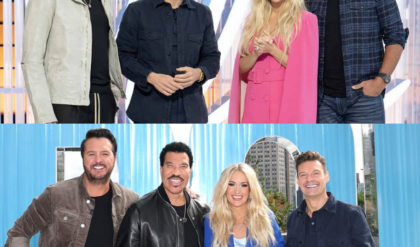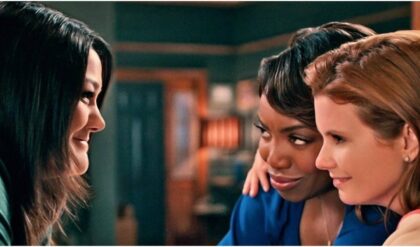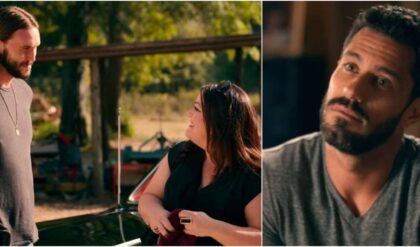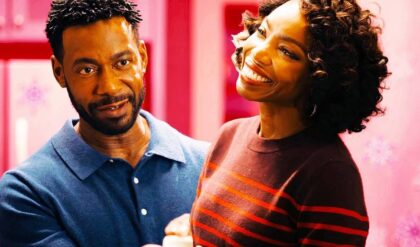Twenty-five years ago, the superstar starred in “Eyes Wide Shut” and “Magnolia,” and opened himself up for the camera in ways he rarely has since.

Illustration by Tala Safie; Photos: New Line Cinema; Warner Bros.
“Eyes Wide Shut” had a blunt sales pitch: Cruise. Kidman. Kubrick.
The poster didn’t need much more. Audiences already knew plenty. At the peak of his clout, having just earned his second Oscar nomination, for “Jerry Maguire,” and publicly launched his production company with “Mission: Impossible,” Tom Cruise and his wife at the time, Nicole Kidman, ditched Hollywood to quietly make a dirty movie in England with the legendary director Stanley Kubrick. The shoot was supposed to last six to eight months. It took 15.
‘’People say: ‘You’ve lost 40, 60, 80 million dollars. You’ve lost all this money. You’ve lost all this time,” Cruise told The New York Times a year before its anticipated release. “To have a chance to work with Stanley Kubrick,” he added, “that’s worth it for me.”
Talk about risky business. The second half of 1999 would prove to be the diciest period of Cruise’s career with the release of two back-to-back films that dared him to expose his private vulnerabilities. The first, “Eyes Wide Shut,” released 25 years ago this summer, was a cerebral and slippery tale about a husband named Dr. Bill Harford who wanders Manhattan for two nights as vague vengeance upon his wife for fantasizing about another man. It was hawked as Cruise after dark — the movie star and his spouse, the ascendant Kidman, inviting people into their bedroom to see how they slept, smooched and argued.
Cruise sacrificed a year and a half of his life for what he hoped would be his major contender, the film that might finally earn him an Academy Award. But ironically, it was the other role that got him an invite to the ceremony: an outrageous supporting bit as the seduction guru Frank T.J. Mackey in Paul Thomas Anderson’s ensemble drama “Magnolia” that Cruise had shot in just three weeks. Of the two performances, it’s by far the most personally revealing.
Image

Nicole Kidman and Tom Cruise, married at the time, playing a couple in “Eyes Wide Shut.”Credit…Warner Bros.
At that time, Cruise was a promiscuous director-gatherer, rarely working with the same filmmaker twice. He aimed for heavyweights: Martin Scorsese, Oliver Stone, Rob Reiner, Ron Howard, Brian De Palma, breaking his ronin inclinations only to make “Top Gun” and “Days of Thunder” with Tony Scott. On “Thunder,” he had fallen in love with Kidman and made another film with her, too — “Far and Away” — and neither had been critically acclaimed.
Cruise hoped Kubrick would change their ho-hum streak, disregarding the hard-won wisdom he’d learned more than a decade earlier when he dinged his post-“Risky Business” momentum to play a forest imp in Ridley Scott’s “Legend.” That flop also suffered from a metastasizing shooting schedule (four months turned into 12) and an auteur more focused on style than emotional substance. After returning from Britain, he told Rolling Stone that he felt like merely “another color in a Ridley Scott painting.”
“I’ll never want to do another picture like that again,” he vowed. Well, he had. He’d even gone back to Pinewood Studios in London.
KUBRICK WAS NEVER an actor’s director. His staggering filmography included only two performances nominated for an Academy Award: Peter Ustinov in “Spartacus,” and Peter Sellers in “Dr. Strangelove” (only Ustinov won). Kubrick’s genius was the star. On “Eyes Wide Shut,” a passion project since the 1960s, his casting priority wasn’t talent — it was convincing a married couple to enlist. (His first choice was Alec Baldwin and Kim Basinger.) Tabloid scrutiny was what Cruise and Kidman believed they’d gone to the great master to escape, only to have Star magazine allege that Kubrick had to hire on-set erotic experts to teach them how to make love. (Cruise not only denied the accusation, but sued over it.)
Fans expecting nudity should have known better. Despite earning the title People’s Sexiest Man Alive in 1990, Cruise disliked pitching himself as an object of desire, refusing to let marketers promote his first blockbuster, “Top Gun,” with shirtless photos of him playing volleyball. In four decades, he has filmed only one genuinely erotic scene — his first-date clinch with Renée Zellweger in “Jerry Maguire” — and a couple of giddy tone-benders that combine sex with death (torturing a victim in “Interview With the Vampire”) or sex with musical comedy (duetting with Malin Akerman in “Rock of Ages”).
Image

Stanley Kubrick, in glasses, working with Tom Cruise, left, and Julienne Davis on the set of “Eyes Wide Shut.”Credit…Kubrick Archive
But Cruise bore the blame when the peek into his life fans had been promised turned out to be a pent-up study of male insecurity. (At an early screening of “Eyes Wide Shut,” LA Weekly reported walkouts and one viewer huffing an expletive.) Critics expecting a charismatic performance at least were also disappointed, with many dismissing Cruise as flat and out of his depth.
“Stanley was not that specific about what he wanted,” Kidman told Time Out London. Yet, Cruise, who developed an ulcer during the film, never said a word against Kubrick, even after filming 95 takes of walking through a door. To this, let me add that it seems difficult for any actor to build a character when they’ve got no idea which one of a hundred versions their director wants — and there’s reason to question whether Kubrick was even using Cruise’s best takes. As the editor Gordon Stainforth said of splicing together “The Shining,” good performances were often rejected in favor of “the most eccentric and rather over-the-top.”
WHILE IN LONDON, CRUISE watched “Boogie Nights” and learned that its director, Anderson, also happened to be in town. Cruise invited him to the set and afterward, Anderson pledged to write him something “un-turn-downable,” as he explained to The New York Times. Six months later, Anderson sent him a script with another sexually frustrated character: a self-proclaimed “master of the muffin” who never even touches a woman onscreen (and the women he knows find him obnoxious). Humping the air for his rowdy male acolytes, Frank might just be a locker-room faker, a try-hard hysteric, an immature blusterer who tries (and fails) to impress a female TV journalist by vaulting into a mostly naked backward somersault with his pants bunched around his ankles.
Cruise was 36 and, for the first time in his career, he would be older than his director — a new-school ’90s Sundance darling. Still, he was determined to impress Anderson, too.
“He’s like, ‘Do you want me to stand on my head, do you want me to do back flips? I’ll do it, I’ll do anything you want,’” Anderson recalled to Rolling Stone.
Image

Cruise in “Magnolia” in a part written for him by the director, Paul Thomas Anderson.Credit…Peter Sorel/New Line Cinema
Cruise’s Frank Mackey is an electric performance — a huckster Elvis roiling with hostility — and in my opinion it should have won him an Oscar. (I say this with zero offense to Michael Caine, who took home the supporting actor prize for “The Cider House Rules” and joked affectionately that the prestige would have lowered the mega movie star’s price tag.) Statuette aside, Cruise deemed it “the perfect character to play after Bill Harford.” Kubrick bottled him up; Anderson cut him loose.
Yet, Bill and Frank share key points of connection. Bill learns that sex is danger, with missed connections involving one sex worker with H.I.V. and another who ends up possibly murdered. Frank’s mission statement is “Seduce and destroy” — and he seems most passionate about inflicting pain. Neither character enjoys the raunchy thrills people imagine he’s enjoying, and both of them hide their real selves under masks (the wealthy doctor literally) as they set out to convince the world of their success and power.
Bill stalks the East Village believing he wants to even the score with his wife, but he’s just piqued there’s an even richer and more powerful crowd that hasn’t yet invited him to their secret orgies. And Frank has buried his entire past — the years caretaking for his late mother, the rage and hurt he feels toward his estranged father, his own last name — to resurrect himself as a carnal superhero whose mind-control powers appear to work only on other men.
The films even share two identical scenes. The first is a long, mute stare as Cruise’s characters discover themselves completely emasculated by women they’ve underestimated — a crucial pivot point in both movies. The second comes in a climactic collapse before the family member who cut them so deeply that they’ve dreaded coming home. Both men stumble toward the unconscious body of their bittersweet beloved — Bill’s sleeping wife, Frank’s dying father — struggling to keep their emotions in check. Then they burst into sobs.
Image

Cruise confronting his character’s dying father in “Magnolia.”Credit…New Line Cinema
Cruise’s own father, Thomas Cruise Mapother III, was “a bully and a coward,” he told Parade magazine in 2006. Like Frank, Cruise lopped off his dad’s surname to build his reputation on his own. The elder Mapother died of cancer just before his son flew to London for “Legend.” Cruise visited him on his deathbed. It was the first time they’d seen each other in years, but they didn’t talk about the past. Cruise just held his hand.
Not long after, he opened up about that last goodbye. “It cleared up a lot of kind of fog that I had about the man,” Cruise told Rolling Stone in that 1986 interview. “It’s all sort of complex. There wasn’t one thing I felt.”
“I don’t know what I would have done without my work,” he continued. “It gave me a place to deal with all those emotions.”
And “Magnolia” gave him a place to honor them. That two-minute take in which Mackey breaks down at his father’s bedside is the most naked Cruise has ever been onscreen — an authentically heart-rending moment of release.
I believe that the first two decades-plus of Cruise’s career, from that famous sunglasses-and-socks skid in 1983 to that infamous (and overblown) couch jump in 2005, is one brilliant, underestimated performance after another, a superstar dominion so dazzling that audiences missed the subtle acting underneath. Yet, even amid this rarefied winning streak, the films he released in 1999 stand tall as testimonies to his courage. Today, Cruise is more acclaimed for braving risky stunts, not risky roles. I hope he dares himself to bare it all for the camera again.





